Forex trading can be both exciting and challenging, especially for those looking to maximize their trading strategies. One tool that many traders find invaluable is the Zigzag indicator. This article will provide a comprehensive guide on how to use the Zigzag indicator in forex trading with the support of a forex broker, ensuring you understand its functionality, application, and best practices to enhance your trading performance. By delving deep into its mechanisms, strategies, and practical applications, you’ll be equipped to leverage the Zigzag indicator effectively in your trading endeavors.
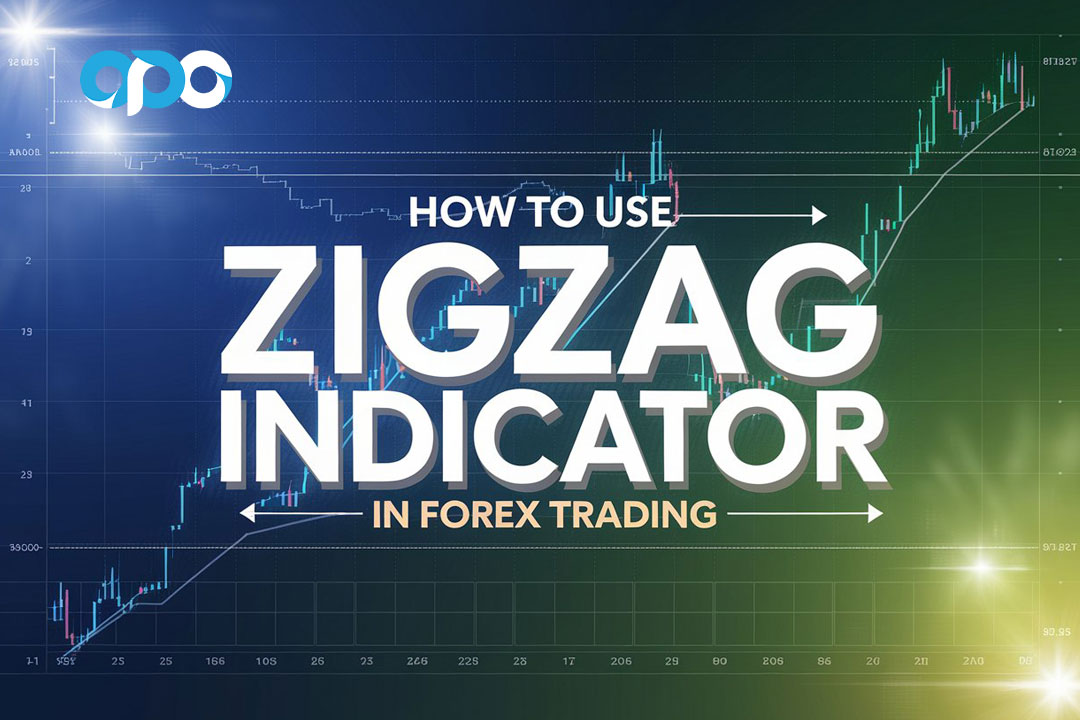
Introduction to the Zigzag Indicator
The Zigzag indicator is a popular tool among forex traders, designed to simplify price movements by filtering out minor fluctuations. In the volatile world of forex trading, identifying significant trends is crucial for making informed trading decisions. The Zigzag indicator achieves this by focusing only on substantial price changes, thereby providing a clearer picture of market trends and potential reversal points. This article delves into the definition and purpose of the Zigzag indicator, its operational mechanics, and effective strategies to integrate it into your trading plan. Additionally, we’ll explore how combining the Zigzag indicator with other tools can optimize your trading outcomes.
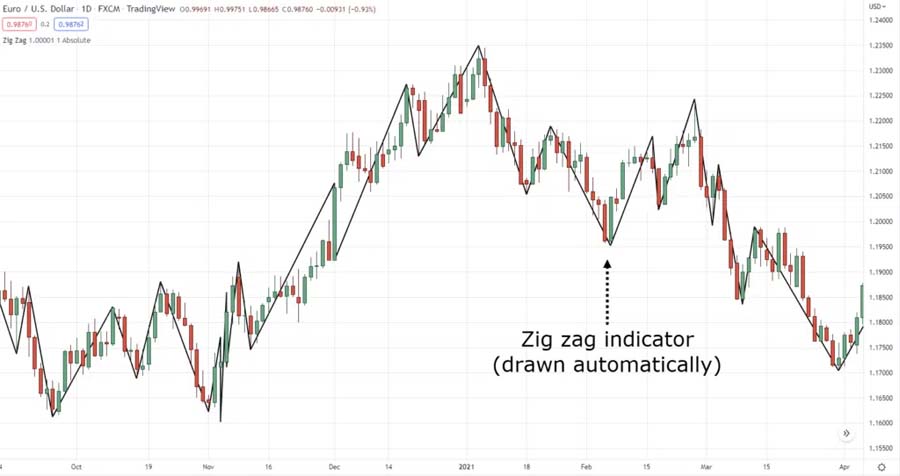
Choosing a regulated forex broker is essential for implementing effective trading strategies, and using the Zigzag indicator with a reliable broker can significantly enhance your trading experience. A trustworthy broker ensures that the tools you use, including the Zigzag indicator, function optimally and that your trades are executed smoothly and securely.
Read More: The volume indicator in Forex tr
How the Zigzag Indicator Works
The Zigzag indicator operates by highlighting price movements that exceed a specified threshold, effectively filtering out insignificant price changes. This simplification allows traders to focus on the most meaningful trends and patterns within the forex market.
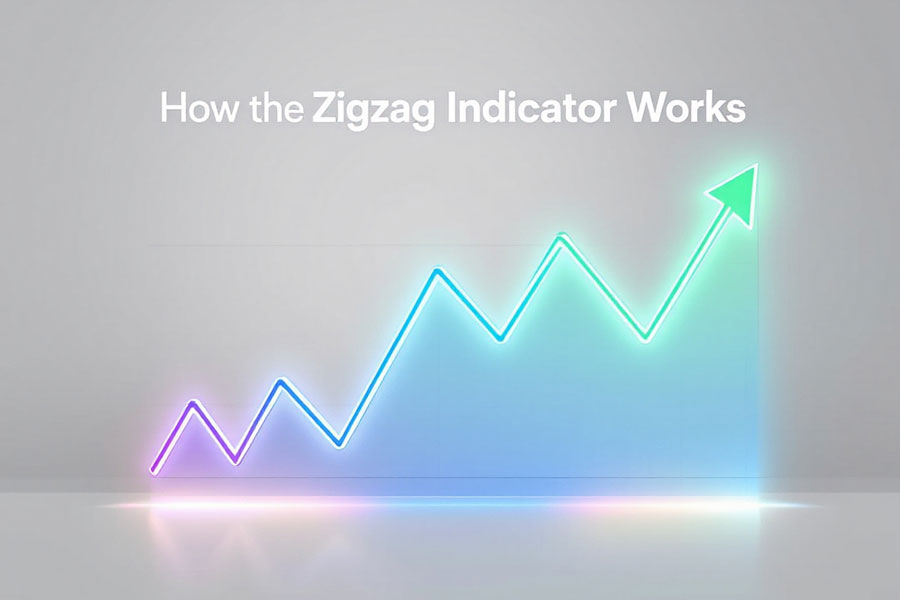
Mechanism of the Zigzag Indicator
The primary function of the Zigzag indicator is to identify significant price movements by setting a threshold for price changes. When the price moves beyond this set threshold, the indicator plots a new line, creating a zigzag pattern on the chart. This helps in visualizing the prevailing trend by eliminating minor price oscillations.
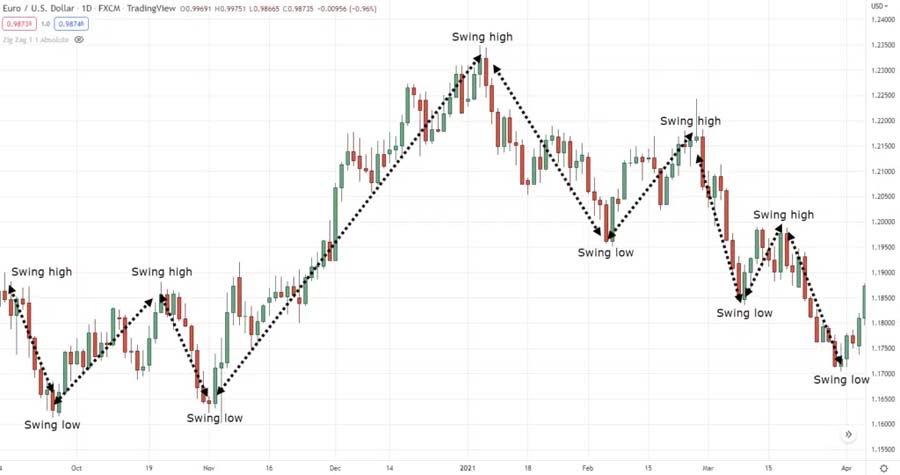
The Zigzag indicator calculates price changes based on the defined depth, deviation, and backstep parameters. These parameters determine how sensitive the indicator is to price movements, ensuring that only significant trends are captured and minor fluctuations are ignored.
Common Settings
Understanding the common settings of the Zigzag indicator is essential for tailoring it to different market conditions:
- Depth: Determines the number of bars to look back for a significant price movement. A higher depth setting makes the indicator less sensitive to price changes, focusing on longer-term trends.
- Deviation: Sets the percentage change in price required to plot a new zigzag line. Higher deviation values reduce the number of signals, filtering out more noise.
- Backstep: Defines the minimum number of bars between two successive zigzag points. This helps prevent the indicator from generating too many signals in quick succession.
Adjusting these settings based on the specific forex market conditions can enhance the accuracy of the signals generated by the Zigzag indicator. For example, in highly volatile markets, a higher deviation might be necessary to avoid false signals, whereas in stable markets, a lower deviation can help capture more precise trend changes.
Setting Up the Zigzag Indicator
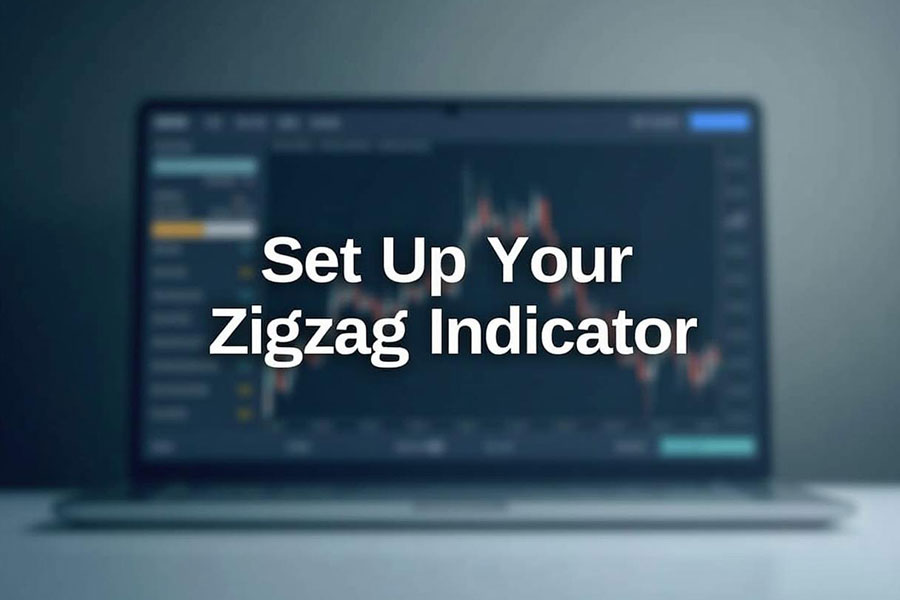
Setting up the Zigzag indicator on your trading platform is straightforward. Here’s a step-by-step guide using MetaTrader 4, one of the most popular trading platforms among forex traders.
Step-by-Step Guide to Adding the Indicator
- Open MetaTrader 4 and navigate to the Navigator panel.
- Under the Indicators section, locate the Zigzag indicator.
- Drag and drop the Zigzag indicator onto your desired chart.
- A settings window will appear where you can customize the indicator parameters.
Recommended Settings Based on Market Conditions
- Trending Markets:
- Depth: 12
- Deviation: 5
- Backstep: 3
- Range-Bound Markets:
- Depth: 8
- Deviation: 3
- Backstep: 2
Adjusting the settings according to the market condition ensures that the Zigzag indicator provides the most relevant signals for your trading strategy. For instance, in a trending market, a higher depth and deviation can help in capturing major trend movements, while in a range-bound market, lower settings can help identify key reversal points within the range.
Advanced Configuration Tips
For traders seeking to refine their use of the Zigzag indicator, consider the following advanced tips:
- Multi-Timeframe Analysis: Apply the Zigzag indicator on multiple timeframes to gain a broader perspective of the market trend. Using it on both daily and hourly charts can help identify major trends and short-term reversals.
- Customization: Beyond the standard settings, some platforms allow for further customization of the Zigzag indicator, such as changing the color and thickness of the lines, which can aid in better visual analysis.
- Combination with Alerts: Setting up alerts based on Zigzag signals can help traders stay informed about potential trading opportunities without constantly monitoring the charts.
Read More: how to use bollinger bands in forex trading
Interpreting the Zigzag Indicator
Once set up, interpreting the Zigzag indicator is crucial for leveraging its full potential in your trading strategy.
Reading the Lines Plotted by the Indicator
The Zigzag indicator plots lines that connect significant price points, creating a zigzag pattern. These lines represent the peaks and troughs of price movements, helping traders identify the direction and strength of the trend. Each line segment signifies a major price move, either upward or downward, based on the set deviation threshold.
In an uptrend, the Zigzag lines will connect higher highs and higher lows, while in a downtrend, they will connect lower highs and lower lows. This visual representation makes it easier to discern the underlying trend amidst the market noise.
Identifying Trends
- Bullish Trends: Upward lines indicate a bullish trend, suggesting that the market is moving upwards.
- Bearish Trends: Downward lines indicate a bearish trend, signaling a downward market movement.
By analyzing the direction of these lines, traders can make informed decisions about entering or exiting trades based on the prevailing market trend. Additionally, the slope of the Zigzag lines can provide insights into the strength of the trend; steeper lines typically indicate stronger trends, while flatter lines suggest weaker movements.
Zigzag Trading Strategies
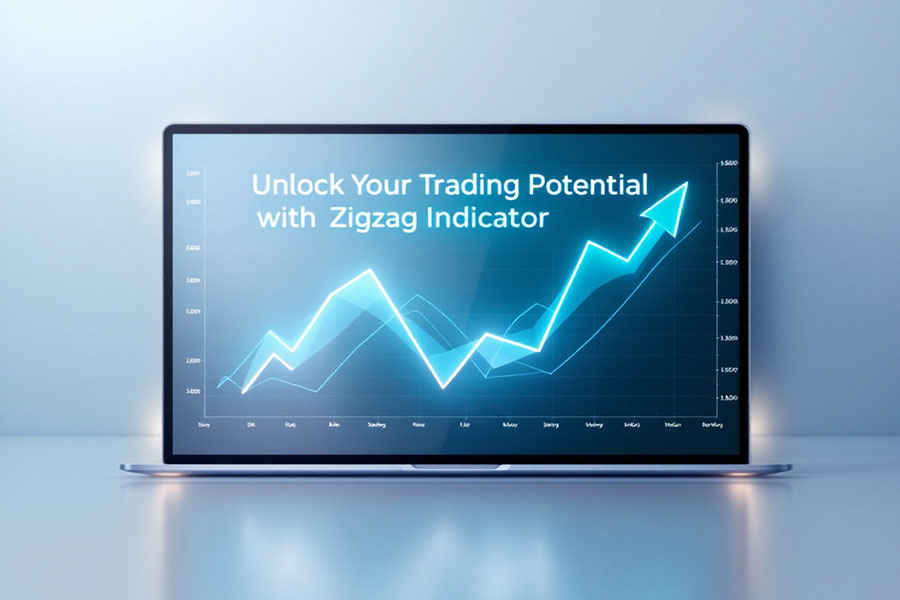
The Zigzag indicator can be employed in various trading strategies to enhance decision-making and improve trading outcomes. Below are some of the most effective strategies utilizing the Zigzag indicator.
Trend Confirmation
Using the Zigzag indicator to confirm existing trends is a fundamental strategy. When the indicator aligns with other trend-following tools, it reinforces the validity of the trend, providing stronger signals for entry or exit.
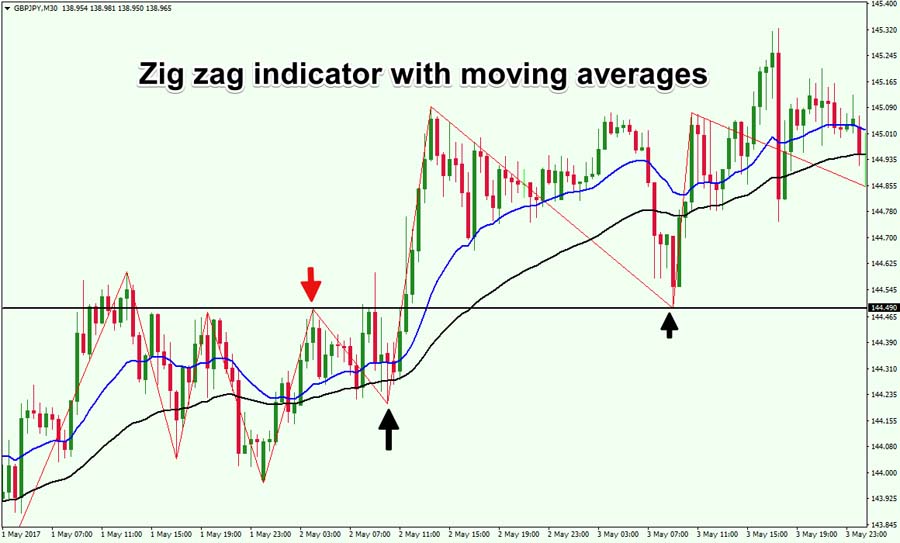
How It Works:
- Combine the Zigzag indicator with moving averages (e.g., 50-period and 200-period).
- If the Zigzag lines are trending upwards and the price is above the moving averages, it confirms a bullish trend.
- Conversely, if the Zigzag lines are trending downwards and the price is below the moving averages, it confirms a bearish trend.
Swing Trading
Swing trading involves capturing short- to medium-term price movements. The Zigzag indicator helps identify swing points, enabling traders to determine optimal entry and exit points within the trend.
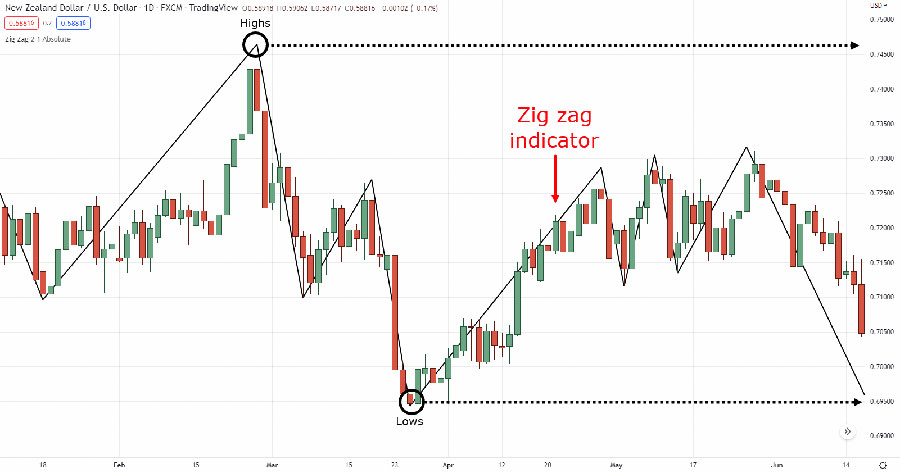
How It Works:
- Identify swing highs and swing lows using the Zigzag indicator.
- Enter a trade when the price breaks above a swing high (for longs) or below a swing low (for shorts).
- Set stop-loss orders just below the previous swing low (for longs) or above the previous swing high (for shorts).
Divergence Trading
Divergence occurs when there is a discrepancy between price movements and the indicator. Recognizing divergences between the Zigzag indicator and price actions can signal potential reversals, offering lucrative trading opportunities.
How It Works:
- Compare the Zigzag lines with price movements to identify divergences.
- A bullish divergence occurs when the price makes a lower low, but the Zigzag indicator forms a higher low.
- A bearish divergence occurs when the price makes a higher high, but the Zigzag indicator forms a lower high.
Support and Resistance
The Zigzag indicator is effective in identifying key support and resistance levels. By pinpointing these critical levels, traders can set more accurate stop-loss and take-profit orders, enhancing risk management.
How It Works:
- Use the swing highs and swing lows identified by the Zigzag indicator to establish support and resistance levels.
- These levels act as potential points for price reversal or breakout.
- Traders can place buy orders near support levels and sell orders near resistance levels.
Implementing these strategies with the Zigzag indicator can significantly improve your trading accuracy and profitability. By systematically applying these approaches, traders can better navigate the complexities of the forex market and make more informed trading decisions.
Read More: Fractals Indicator in Forex Trading
Zig Zag Indicator Trading Strategy
Developing a robust zig zag indicator trading strategy involves combining the Zigzag indicator with other technical tools to enhance signal reliability. This strategy focuses on identifying trend reversals and continuations by analyzing the significant price movements filtered by the Zigzag indicator.
Key Components:
- Trend Identification: Utilize the Zigzag indicator to determine the prevailing market trend by connecting major swing points.
- Entry Signals: Generate entry signals based on the interaction between the price and the Zigzag lines, ensuring alignment with the identified trend.
- Exit Strategies: Define exit points using the Zigzag indicator’s swing highs and lows to secure profits and manage risk effectively.
By integrating these components, traders can develop a comprehensive zig zag indicator trading strategy that adapts to various market conditions, enhancing overall trading performance.
Common Mistakes to Avoid

While the Zigzag indicator is a powerful tool, avoiding common pitfalls ensures its effectiveness in your trading strategy.
Relying Solely on the Zigzag Indicator
One of the most common mistakes is depending exclusively on the Zigzag indicator without incorporating additional tools. Using complementary indicators such as RSI or moving averages can provide a more comprehensive analysis, reducing the likelihood of false signals.
Why It’s a Mistake:
- The Zigzag indicator is primarily a trend visualization tool and does not provide entry or exit signals on its own.
- Without confirmation from other indicators, signals from the Zigzag indicator may lead to premature or incorrect trading decisions.
Solution:
- Combine the Zigzag indicator with momentum indicators like RSI or MACD to confirm the strength of the trend.
- Use volume indicators to validate the significance of price movements highlighted by the Zigzag indicator.
Misconfiguring Settings
Incorrectly setting the parameters of the Zigzag indicator can lead to ineffective signals. It’s essential to adjust the depth, deviation, and backstep settings based on the specific market conditions to ensure accurate trend identification.
Why It’s a Mistake:
- Overly sensitive settings can result in too many false signals, cluttering the chart and causing confusion.
- Insensitive settings may miss out on significant trend reversals, leading to missed trading opportunities.
Solution:
- Regularly review and adjust the indicator settings based on the current market volatility and trading timeframe.
- Conduct thorough backtesting to determine the optimal settings for different market conditions.
Ignoring Market Context
Another mistake is ignoring the broader market context when using the Zigzag indicator. Market conditions such as economic events, geopolitical developments, and overall market sentiment can significantly impact the effectiveness of the indicator.
Why It’s a Mistake:
- The Zigzag indicator does not account for external factors that can influence price movements.
- Trading solely based on the indicator without considering market context can lead to unexpected losses.
Solution:
- Stay informed about major economic and political events that could affect the forex market.
- Incorporate fundamental analysis alongside technical tools like the Zigzag indicator to make more informed trading decisions.
Overlooking Risk Management
Neglecting proper risk management is a critical error when using any trading indicator, including the Zigzag. Without adequate risk controls, even the most accurate signals can lead to significant losses.
Why It’s a Mistake:
- Failing to set stop-loss and take-profit levels increases the risk of substantial losses.
- Poor risk management can lead to emotional trading, which often results in irrational decision-making.
Solution:
- Always set predefined stop-loss and take-profit levels based on the Zigzag indicator’s signals.
- Use position sizing techniques to manage risk effectively and protect your trading capital.
Best Practices for Using the Zigzag Indicator
Adhering to best practices maximizes the benefits of the Zigzag indicator in your trading strategy.
Combining with Other Indicators
Integrating the Zigzag indicator with other technical tools like Fibonacci retracements or Relative Strength Index (RSI) can enhance your analysis. This combination provides a more robust framework for making informed trading decisions.
Benefits:
- Enhanced Confirmation: Using multiple indicators can confirm the signals, increasing their reliability.
- Comprehensive Analysis: Different indicators offer various perspectives, leading to a more holistic market view.
Example: A trader uses the Zigzag indicator to identify swing points and then applies Fibonacci retracement levels to these points. Simultaneously, the RSI is used to gauge the momentum. If the price reaches a Fibonacci level and the RSI indicates oversold conditions, it strengthens the signal to enter a long position.
Importance of Backtesting Strategies
Before deploying strategies in live trading, backtesting them using historical data is crucial. This process helps in validating the effectiveness of the Zigzag indicator settings and trading strategies, ensuring they perform well under various market conditions.
Benefits:
- Strategy Validation: Backtesting provides evidence of a strategy’s potential profitability and reliability.
- Risk Assessment: It helps identify potential risks and areas for improvement in the trading strategy.
How to Backtest:
- Choose Historical Data: Select a period that includes different market conditions (trending, range-bound, volatile).
- Apply the Zigzag Indicator: Use the chosen settings to identify swing points and trends.
- Simulate Trades: Based on the Zigzag signals, simulate trades and track their performance.
- Analyze Results: Evaluate the success rate, profitability, and risk metrics of the strategy.
Implementing these best practices fosters a disciplined and effective trading approach, leveraging the full potential of the Zigzag indicator.
Continuous Learning and Adaptation
The forex market is dynamic, and successful traders continuously adapt their strategies to evolving market conditions. Staying updated with the latest developments and refining your use of the Zigzag indicator can lead to sustained trading success.
Strategies for Continuous Learning:
- Educational Resources: Regularly read books, attend webinars, and follow reputable trading blogs to enhance your knowledge.
- Community Engagement: Participate in trading forums and communities to exchange ideas and learn from experienced traders.
- Performance Review: Periodically review your trading performance to identify strengths and areas for improvement.
Example: A trader notices that the effectiveness of the Zigzag indicator diminishes during periods of low volatility. By adapting their strategy to use a different deviation setting or incorporating volatility indicators, they can maintain the indicator’s effectiveness across various market conditions.
Opofinance Services
When utilizing the Zigzag indicator in your trading strategies, partnering with a reliable broker is paramount. Opofinance, an ASIC regulated forex broker, offers exceptional services tailored to enhance your trading experience. Their social trading service allows you to connect with and learn from experienced traders, fostering a collaborative trading environment. This feature is particularly beneficial for those looking to adopt and refine strategies involving the Zigzag indicator, as it provides access to diverse trading insights and techniques.

Additionally, Opofinance is officially featured on the MT5 brokers list, ensuring compatibility and seamless integration with the MetaTrader 5 platform. This allows traders to leverage the advanced features of MT5, including enhanced charting tools and faster execution speeds, further optimizing the use of the Zigzag indicator in their trading strategies.
With safe and convenient deposit and withdrawal methods, Opofinance provides a secure and efficient trading environment, making it an excellent choice for both novice and seasoned traders. Their commitment to regulatory compliance and client security ensures that your trading activities are conducted in a trustworthy and reliable manner.
Conclusion
The Zigzag indicator is a versatile tool that can significantly enhance your forex trading strategy. By understanding its functionality, setting it up correctly, and integrating it with other indicators, you can filter out noise, identify trends, and make informed trading decisions. Remember to avoid common mistakes such as relying solely on the Zigzag indicator and misconfiguring its settings. Incorporating best practices like combining it with other technical tools and backtesting your strategies will further optimize your trading performance. Experiment with different settings and strategies to find what works best for your trading style and market conditions.
Embracing the Zigzag indicator as part of a comprehensive trading approach can lead to more disciplined and successful trading outcomes. Coupled with a reliable broker like Opofinance, you can navigate the complexities of the forex market with confidence and precision.
What are the key parameters to adjust in the Zigzag indicator for optimal performance?
The key parameters to adjust in the Zigzag indicator include depth, deviation, and backstep. Adjusting these settings based on market volatility and trading timeframe is essential for capturing significant trends and minimizing false signals.
Can the Zigzag indicator be integrated with automated trading systems?
Yes, the Zigzag indicator can be integrated with automated trading systems. By combining it with algorithmic strategies, traders can automate the identification of trend reversals and execute trades based on predefined Zigzag signals.
How does market volatility affect the effectiveness of the Zigzag indicator?
Market volatility significantly affects the effectiveness of the Zigzag indicator. In highly volatile markets, higher deviation settings may be necessary to filter out excessive noise, while in less volatile markets, lower deviation settings can help capture more precise trend changes.







